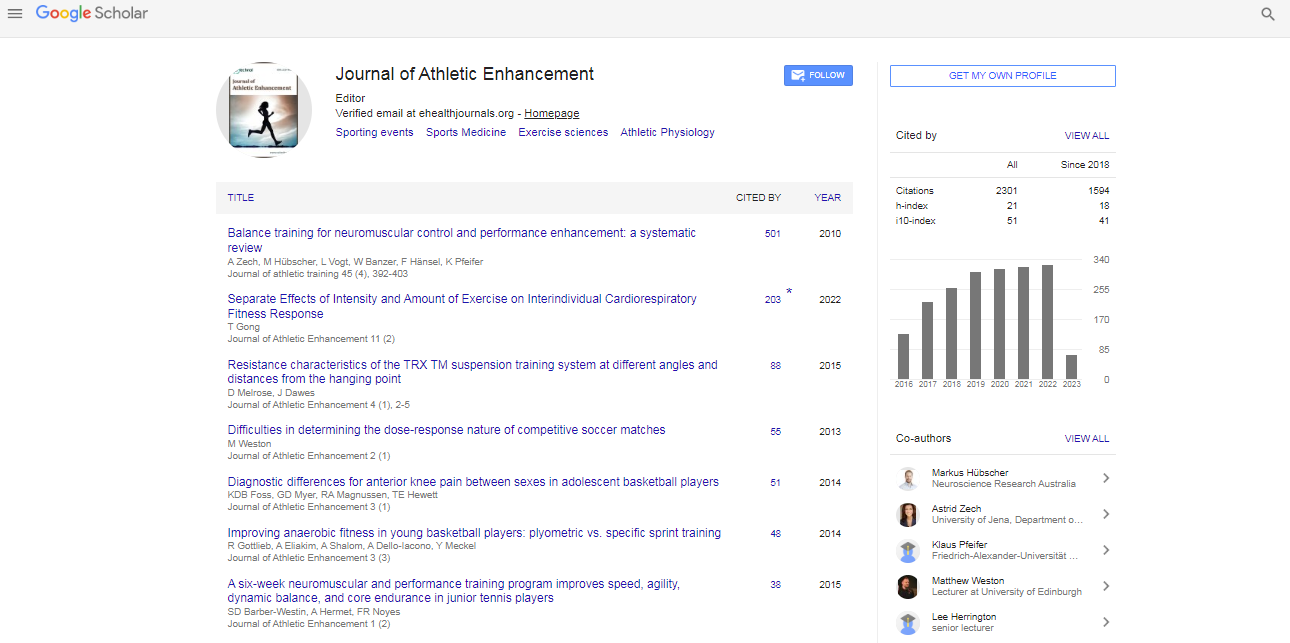Short Communication, J Athl Enhanc Vol: 13 Issue: 4
Gym to Field: Sport-Specific Nutrition for Every Athlete
Jenny France*
Department of Sports, Wuhan Sports University, Wuhan, China
*Corresponding Author: Zhang Xuan,
Department of Sports, Wuhan Sports
University, Wuhan,
China;
E-mail: xuanzhang@edu.cn
Received date: 28 June, 2024, Manuscript No. JAE-24-144919;
Editor assigned date: 01 July, 2024, PreQC No. JAE-24-144919 (PQ);
Reviewed date: 15 July, 2024, QC No. JAE-24-144919;
Revised date: 22 July, 2024, Manuscript No. JAE-24-144919 (R);
Published date: 29 July, 2024, DOI: 10.4172/2324-9080.1000142
Citation: France J (2024) Gym to Field: Sport-Specific Nutrition for Every Athlete. J Athl Enhanc 13:4.
Description
In the world of sports and physical performance, nutrition serves as an important key for enhancing both training outcomes and competitive success. Whether an athlete is training in the gym or competing on the field, sport-specific nutrition strategies are essential for optimizing performance, promoting recovery and maintaining overall health.
Understanding sport-specific needs
Athletes engage in various activities that demand different energy systems, muscle groups and metabolic pathways. Thus, a one-sizefits- all approach to nutrition is inadequate. For instance, the nutritional needs of a sprinter differ markedly from those of a marathon runner or a weightlifter [1].
Endurance sports: Athletes involved in endurance sports, such as long-distance running or cycling, rely heavily on aerobic metabolism. Carbohydrates are their primary fuel source because they provide readily available energy for sustained activity. Endurance athletes should consume a diet rich in complex carbohydrates like whole grains, fruits and vegetables. Additionally, they need to focus on electrolyte replenishment, as extended exercise leads to significant loss of sodium, potassium and other vital minerals [2-4].
Strength and power sports: Sports like weightlifting, bodybuilding, or sprinting emphasize anaerobic energy systems. For these athletes, protein intake becomes important for muscle repair and growth. A diet rich in lean proteins, such as chicken, fish and legumes, supports muscle synthesis and recovery. Carbohydrates remain important to replenish glycogen stores and fuel high-intensity workouts, but the focus is often on timing consuming protein and carbs shortly after exercise can enhance recovery [5].
Team sports: Athletes in team sports, like soccer, basketball, or rugby, require a balance between endurance and strength. Their nutrition needs include a mix of carbohydrates for energy, protein for muscle maintenance and fats for overall health. Hydration is also important, given the variable intensity and duration of team sports activities. Consuming a balanced diet with a mix of macro and micronutrients ensures that athletes can perform at their best throughout their games [6].
Practical nutrition strategies
Implementing effective sport-specific nutrition strategies involves not just understanding the right types of foods to eat, but also when and how to consume them.
Pre-workout nutrition: Eating a balanced meal or snack before exercise can help maximize performance. Ideally, this meal should include a mix of carbohydrates and protein, consumed 1-3 hours prior to the activity. For high-intensity workouts, a smaller, easily digestible snack, like a banana or a protein bar, can be beneficial closer to the workout time [7].
During exercise: For prolonged or intense sessions, consuming carbohydrates and electrolytes can help sustain energy levels and delay fatigue [8]. Sports drinks, gels, or snacks like pretzels can be effective.
Post-workout recovery: Post-exercise nutrition focuses on replenishing glycogen stores and repairing muscles [9]. A combination of protein and carbohydrates, consumed within 30-60 minutes after exercise, supports recovery.
In the journey from the gym to the field, nutrition acts as a powerful ally for athletes striving to enhance their performance. By adopting sport-specific and individualized nutrition strategies, athletes can better meet their unique energy and recovery needs [10]. Understanding the interaction between diet and exercise not only promotes optimal performance but also supports long-term health and well-being. As research and technology continue to evolve, so too will our understanding of sport-specific nutrition, paving the way for even more tailored and effective strategies in the future.
References
- Bouhlel MA, Derudas B, Rigamonti E, Dièvart R, Brozek J, et al (2007) PPARγ activation primes human monocytes into alternative M2 macrophages with anti-inflammatory properties. Cell Metab 6(2):137-143.
- Bird A (2002) DNA methylation patterns and epigenetic memory. Genes Dev 16(1):6-21.
- Jones PA, Takai D (2001) The role of DNA methylation in mammalian epigenetics. Science 293(5532):1068-1070.
- Suzuki MM, Bird A (2008) DNA methylation landscapes: provocative insights from epigenomics. Nat Rev Genet 9(6):465-476.
- Wu SC, Zhang Y (2010) Active DNA demethylation: many roads lead to Rome. Nat Rev Mol Cell Biol 11(9):607-620.
- Esteller M (2008) Epigenetics in cancer. N Engl J Med 358(11):1148-1159.
- Lakshminarasimhan R, Liang G (2016) The role of DNA methylation in cancer. Adv Exp Med Biol 151-172.
- Counts JL, Goodman JI (1995) Hypomethylation of DNA: a possible epigenetic mechanism involved in tumor promotion. Prog Clin Biol Res 391:81-101.
- Cai W, Yang T, Liu H, Han L, Zhang K, et al (2018) Peroxisome proliferator-activated receptor γ (PPARγ): A master gatekeeper in CNS injury and repair. Prog Neurobiol 163:27-58.
- Kabiri S, Choi J, Shadmanfaat SM, Lee J (2021) Control deficits, conditioning factors, and playing through pain and injury among Iranian professional soccer players. Int J Environ Res Public Health 18(7):3387.
 Spanish
Spanish  Chinese
Chinese  Russian
Russian  German
German  French
French  Japanese
Japanese  Portuguese
Portuguese  Hindi
Hindi 
